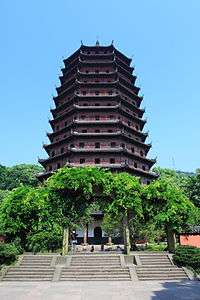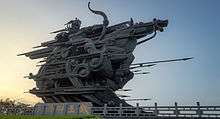Qiantang River
| Qiantang River | |||||||||||||
|
| |||||||||||||
| Simplified Chinese | 钱塘江 | ||||||||||||
|---|---|---|---|---|---|---|---|---|---|---|---|---|---|
| Traditional Chinese | 錢塘江 | ||||||||||||
| Postal | Chientang River | ||||||||||||
| |||||||||||||

The Qiantang River (Chinese: 钱塘江) or Qian River is an East Chinese river that originates in the border region of Anhui and Jiangxi provinces. Its upper stretch is called the Xin'an River, and the middle stretch the Fuchun River (富春). An important commercial artery, it runs for 459 kilometers (285 mi) through Zhejiang, passing through the provincial capital Hangzhou before flowing into the East China Sea via Hangzhou Bay. The river was the southern terminus of the ancient Grand Canal that links five major rivers in China from north to south, and enables water-borne traffic to travel inland from Hangzhou as far north as Beijing.
The Qiantang was historically known as the Zhe River or Zhejiang, which gives the name to the province.[1]
Tidal bore


The river and the Hangzhou Bay are known for the world's largest tidal bore. The oldest known tide table (AD 1056) is for the Qiantang River and may have aided ancient tourists wishing to see the famous tidal bore.[2] The tide rushing into the river mouth from the bay causes a bore which can reach up to 9 metres (30 ft) in height, and travel at up to 40 km per hour (25 miles an hour). Known locally as the Silver (or Black) Dragon, the wave sweeps past Hangzhou, menacing shipping in the harbor.
Recent events
In August 2013, the tidal bore turned out stronger than expected due to Typhoon Trami, reaching more than twice its usual height as it broke on the flood barrier, sweeping it and injuring numerous spectators.
There have been attempts to surf the tidal bore. The 1984 record was 11 seconds by Stuart Matthews.[3] Then, in October 2007, a group of international surfers brought by Antony Colas, did several attempts, one wave being ridden continuously by French Patrick Audoy and Brazilian Eduardo Bagé for 1h10min, for 17 km. In September 2008 a group of American surfers convinced the Chinese government to allow them to surf a section of the river.[4]
In November 2013, Red Bull held the first surf competition on the river, called the Qiantang Shoot Out. The bore was considered the most unusual wave in the world for a surfing contest.[5]
Tributaries
References
- ↑ Paul A. Cohen (2000). "Chiang Kai-Shek". The History. Columbia University Press. p. 71.
- ↑ Zuosheng, Y.; Emery, K.O. & Yui, X. (1989). "Historical development and use of thousand-year-old tide-prediction tables". Limnology and Oceanography. 34 (5): 953–957. doi:10.4319/lo.1989.34.5.0953.
- ↑ "Tsunami-Like River Tides Are Surfing's New Frontier". National Geographic. 2010-10-28. Retrieved 2012-10-11.
- ↑ Cianciulli, Mike (2008-09-18). "China Surf Blog, Round Two: Final Day(s)". Surfline.com. Retrieved 2012-10-11.
- ↑ "Surfing The Qiantang River in Hangzhou, China".
- "
 A Visit to the Hangchow Bore I" Popular Science Monthly Volume 72 Wikisource February 1908 ISSN 0161-7370
A Visit to the Hangchow Bore I" Popular Science Monthly Volume 72 Wikisource February 1908 ISSN 0161-7370 - "
 A Visit to the Hangchow Bore II" Popular Science Monthly Volume 72 Wikisource March 1908 ISSN 0161-7370
A Visit to the Hangchow Bore II" Popular Science Monthly Volume 72 Wikisource March 1908 ISSN 0161-7370
External links
| Wikimedia Commons has media related to Qiantang River. |
Coordinates: 30°22′46″N 120°41′20″E / 30.3794°N 120.6889°E